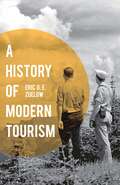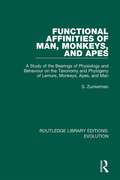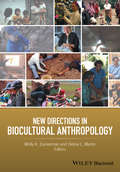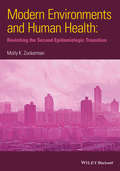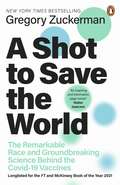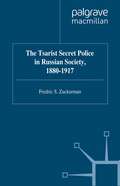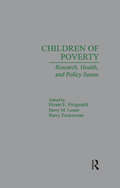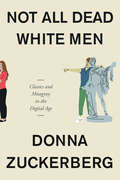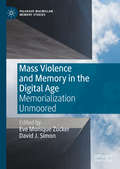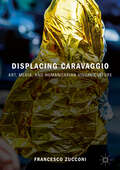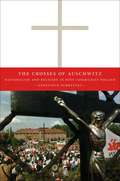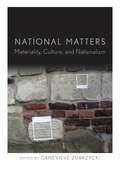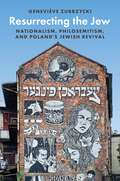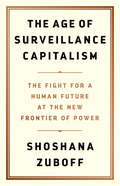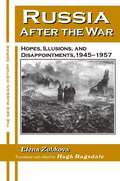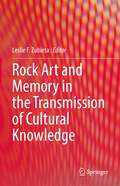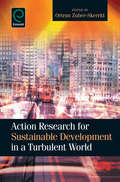- Table View
- List View
A History of Modern Tourism
by Eric ZuelowTourism is one of the largest industries in the world, yet leisure travel is more than just economically important. It plays a vital role in defining who we are by helping to place us in space and time. In so doing, it has aesthetic, medical, political, cultural, and social implications. However, it hasn't always been so. Tourism as we know it is a surprisingly modern thing, both a product of modernity and a force helping to shape it. A History of Modern Tourism is the first book to track the origins and evolution of this pursuit from earliest times to the present. From a new understanding of aesthetics to scientific change, from the invention of steam power to the creation of aircraft, from an elite form of education to family car trips to see national 'shrines,' this book offers a sweeping and engaging overview of a fascinating story not yet widely known.
Functional Affinities of Man, Monkeys, and Apes: A Study of the Bearings of Physiology and Behaviour on the Taxonomy and Phylogeny of Lemurs, Monkeys, Apes, and Man (Routledge Library Editions: Evolution #15)
by S. ZuckermanOriginally published in 1933 Functional Affinities of Man, Monkeys and Apes gives a taxonomic and phylogenetic survey and the findings of diverse experimental investigations of lemurs, monkeys, and apes. The book discusses the inter-relationships of different Primates and emphasizes seldom-used approaches to the question of primate phylogeny. The book attempts to show how little they have been systematically tried, and argues for a regard to the proper place of functional investigations in the study of the classification and evolution of Primates. This book will be of interest to anthropologists, scientists and historians alike.
Functional Affinities of Man, Monkeys, and Apes: A Study of the Bearings of Physiology and Behaviour on the Taxonomy and Phylogeny of Lemurs, Monkeys, Apes, and Man (Routledge Library Editions: Evolution #15)
by S. ZuckermanOriginally published in 1933 Functional Affinities of Man, Monkeys and Apes gives a taxonomic and phylogenetic survey and the findings of diverse experimental investigations of lemurs, monkeys, and apes. The book discusses the inter-relationships of different Primates and emphasizes seldom-used approaches to the question of primate phylogeny. The book attempts to show how little they have been systematically tried, and argues for a regard to the proper place of functional investigations in the study of the classification and evolution of Primates. This book will be of interest to anthropologists, scientists and historians alike.
New Directions in Biocultural Anthropology
by Molly K. Zuckerman Debra L. MartinBiocultural or biosocial anthropology is a research approach that views biology and culture as dialectically and inextricably intertwined, explicitly emphasizing the dynamic interaction between humans and their larger social, cultural, and physical environments. The biocultural approach emerged in anthropology in the 1960s, matured in the 1980s, and is now one of the dominant paradigms in anthropology, particularly within biological anthropology. This volume gathers contributions from the top scholars in biocultural anthropology focusing on six of the most influential, productive, and important areas of research within biocultural anthropology. These are: critical and synthetic approaches within biocultural anthropology; biocultural approaches to identity, including race and racism; health, diet, and nutrition; infectious disease from antiquity to the modern era; epidemiologic transitions and population dynamics; and inequality and violence studies. Focusing on these six major areas of burgeoning research within biocultural anthropology makes the proposed volume timely, widely applicable and useful to scholars engaging in biocultural research and students interested in the biocultural approach, and synthetic in its coverage of contemporary scholarship in biocultural anthropology. Students will be able to grasp the history of the biocultural approach, and how that history continues to impact scholarship, as well as the scope of current research within the approach, and the foci of biocultural research into the future. Importantly, contributions in the text follow a consistent format of a discussion of method and theory relative to a particular aspect of the above six topics, followed by a case study applying the surveyed method and theory. This structure will engage students by providing real world examples of anthropological issues, and demonstrating how biocultural method and theory can be used to elucidate and resolve them. Key features include: Contributions which span the breadth of approaches and topics within biological anthropology from the insights granted through work with ancient human remains to those granted through collaborative research with contemporary peoples. Comprehensive treatment of diverse topics within biocultural anthropology, from human variation and adaptability to recent disease pandemics, the embodied effects of race and racism, industrialization and the rise of allergy and autoimmune diseases, and the sociopolitics of slavery and torture. Contributions and sections united by thematically cohesive threads. Clear, jargon-free language in a text that is designed to be pedagogically flexible: contributions are written to be both understandable and engaging to both undergraduate and graduate students. Provision of synthetic theory, method and data in each contribution. The use of richly contextualized case studies driven by empirical data. Through case-study driven contributions, each chapter demonstrates how biocultural approaches can be used to better understand and resolve real-world problems and anthropological issues.
New Directions in Biocultural Anthropology
by Molly K. Zuckerman Debra L. MartinBiocultural or biosocial anthropology is a research approach that views biology and culture as dialectically and inextricably intertwined, explicitly emphasizing the dynamic interaction between humans and their larger social, cultural, and physical environments. The biocultural approach emerged in anthropology in the 1960s, matured in the 1980s, and is now one of the dominant paradigms in anthropology, particularly within biological anthropology. This volume gathers contributions from the top scholars in biocultural anthropology focusing on six of the most influential, productive, and important areas of research within biocultural anthropology. These are: critical and synthetic approaches within biocultural anthropology; biocultural approaches to identity, including race and racism; health, diet, and nutrition; infectious disease from antiquity to the modern era; epidemiologic transitions and population dynamics; and inequality and violence studies. Focusing on these six major areas of burgeoning research within biocultural anthropology makes the proposed volume timely, widely applicable and useful to scholars engaging in biocultural research and students interested in the biocultural approach, and synthetic in its coverage of contemporary scholarship in biocultural anthropology. Students will be able to grasp the history of the biocultural approach, and how that history continues to impact scholarship, as well as the scope of current research within the approach, and the foci of biocultural research into the future. Importantly, contributions in the text follow a consistent format of a discussion of method and theory relative to a particular aspect of the above six topics, followed by a case study applying the surveyed method and theory. This structure will engage students by providing real world examples of anthropological issues, and demonstrating how biocultural method and theory can be used to elucidate and resolve them. Key features include: Contributions which span the breadth of approaches and topics within biological anthropology from the insights granted through work with ancient human remains to those granted through collaborative research with contemporary peoples. Comprehensive treatment of diverse topics within biocultural anthropology, from human variation and adaptability to recent disease pandemics, the embodied effects of race and racism, industrialization and the rise of allergy and autoimmune diseases, and the sociopolitics of slavery and torture. Contributions and sections united by thematically cohesive threads. Clear, jargon-free language in a text that is designed to be pedagogically flexible: contributions are written to be both understandable and engaging to both undergraduate and graduate students. Provision of synthetic theory, method and data in each contribution. The use of richly contextualized case studies driven by empirical data. Through case-study driven contributions, each chapter demonstrates how biocultural approaches can be used to better understand and resolve real-world problems and anthropological issues.
Modern Environments and Human Health: Revisiting the Second Epidemiological Transition
by Molly K. ZuckermanWritten in an engaging and jargon-free style by a team of international and interdisciplinary experts, Modern Environments and Human Health demonstrates by example how methods, theoretical approaches, and data from a wide range of disciplines can be used to resolve longstanding questions about the second epidemiological transition. The first book to address the subject from a multi-regional, comparative, and interdisciplinary perspective, Modern Environments and Human Health is a valuable resource for students and academics in biological anthropology, economics, history, public health, demography, and epidemiology.
Modern Environments and Human Health: Revisiting the Second Epidemiological Transition
by Molly K. ZuckermanWritten in an engaging and jargon-free style by a team of international and interdisciplinary experts, Modern Environments and Human Health demonstrates by example how methods, theoretical approaches, and data from a wide range of disciplines can be used to resolve longstanding questions about the second epidemiological transition. The first book to address the subject from a multi-regional, comparative, and interdisciplinary perspective, Modern Environments and Human Health is a valuable resource for students and academics in biological anthropology, economics, history, public health, demography, and epidemiology.
A Shot to Save the World: The Remarkable Race and Ground-Breaking Science Behind the Covid-19 Vaccines
by Gregory ZuckermanThis is the definitive account of the global effort to develop a vaccine for Covid-19, charting the failure and success of every major vaccine in use.When the coronavirus pandemic hit, many of the world's biggest drug and vaccine makers were slow to react or couldn't muster an effective response. It was up to a small group of unlikely and untested scientists and executives to save civilization; a French businessman dismissed by many as a fabulist, a Turkish immigrant with little virus experience, a quirky American Midwesterner obsessed with insect cells, a Boston scientist employing questionable techniques, a British scientist despised by his peers. They scrambled to turn their life's work into life-saving vaccines in a matter of months, each gunning to make the big breakthrough - and to beat each other for the glory that a vaccine guaranteed.A number-one New York Times bestselling author and award-winning Wall Street Journal investigative journalist, Zuckerman takes us inside the top-secret laboratories, corporate clashes and high-stakes government negotiations that led to effective vaccines development and roll out. Meticulously reported and endlessly gripping, this is a dazzling, blow-by-blow chronicle of the most consequential scientific breakthrough of our time. It's a story of courage, genius and heroism, optimism. It's also a tale of heated rivalries, unbridled ambitions, crippling insecurities and unexpected drama.A Shot to Save the World is the story of how science saved the world.
The Tsarist Secret Police in Russian Society, 1880-1917 (Studies in Russia and East Europe)
by F. ZuckermanThis is the first book to portray the history of the Russian secret police - the so-called 'Okhrana' - its personnel, world view and interaction with both government and people during the reigns of Alexander III and Nicholas II. The secret police harassed, infiltrated and subverted Russian radical and progressive society as it struggled to preserve Tsardom's traditional political culture in the face of Russia's rapid socio-economic transformation - a transformation which the forces of order scarcely understood, yet deeply despised.
Children of Poverty: Research, Health, and Policy Issues
by Barry S. Zuckerman Hiram E. Fitzgerald Barry M. LesterA collection of the Proceedings of a Society for Research in Child Development Round Table, held in 1993 by the Society for Research in Child Development (SRCD).The intent of the round tables was "to help chart the course for child development research, health care, and public policy for the next ten years". The contributors believe the papers presented and the round table discussions, along with their broader distribution in this volume, do indeed offer useful insights and powerful guidance to researchers, policy makers, and practitioners and interventionists with a vast range of professional training.
Not All Dead White Men: Classics and Misogyny in the Digital Age
by Donna ZuckerbergSome of the most controversial and consequential debates about the legacy of the ancients are raging not in universities but online, where alt-right men’s groups deploy ancient sources to justify misogyny and a return of antifeminist masculinity. Donna Zuckerberg dives deep to take a look at this unexpected reanimation of the Classical tradition.
Mass Violence and Memory in the Digital Age: Memorialization Unmoored (Palgrave Macmillan Memory Studies)
by Eve Monique Zucker David J. SimonThis volume explores the shifting tides of how political violence is memorialized in today's decentralized, digital era. The book enhances our understanding of how the digital turn is changing the ways that we remember, interpret, and memorialize the past. It also raises practical and ethical questions of how we should utilize these tools and study their impacts. Cases covered include memorialization efforts related to the genocides in Rwanda, Cambodia, Europe (the Holocaust), and Armenia; to non-genocidal violence in Haiti, and the Portuguese Colonial War on the African Continent; and of the September 11 attacks on the United States.
Displacing Caravaggio: Art, Media, and Humanitarian Visual Culture
by Francesco ZucconiThis book takes its start from a series of attempts to use Caravaggio’s works for contemporary humanitarian communications. How did his Sleeping Cupid (1608) end up on the island of Lampedusa, at the heart of the Mediterranean migrant crisis? And why was his painting The Seven Works of Mercy (1607) requested for display at a number of humanitarian public events? After critical reflection on these significant transfers of Caravaggio’s work, Francesco Zucconi takes Baroque art as a point of departure to guide readers through some of the most haunting and compelling images of our time. Each chapter analyzes a different form of media and explores a problem that ties together art history and humanitarian communications: from Caravaggio’s attempt to represent life itself as a subject of painting to the way bodies and emotions are presented in NGO campaigns. What emerges from this probing inquiry at the intersection of art theory, media studies and political philosophy is an original critical path in humanitarian visual culture.
The Crosses of Auschwitz: Nationalism and Religion in Post-Communist Poland
by Geneviève ZubrzyckiIn the summer and fall of 1998, ultranationalist Polish Catholics erected hundreds of crosses outside Auschwitz, setting off a fierce debate that pitted Catholics and Jews against one another. While this controversy had ramifications that extended well beyond Poland’s borders, Geneviève Zubrzycki sees it as a particularly crucial moment in the development of post-Communist Poland’s statehood and its changing relationship to Catholicism. In The Crosses of Auschwitz, Zubrzycki skillfully demonstrates how this episode crystallized latent social conflicts regarding the significance of Catholicism in defining “Polishness” and the role of anti-Semitism in the construction of a new Polish identity. Since the fall of Communism, the binding that has held Polish identity and Catholicism together has begun to erode, creating unease among ultranationalists. Within their construction of Polish identity also exists pride in the Polish people’s long history of suffering. For the ultranationalists, then, the crosses at Auschwitz were not only symbols of their ethno-Catholic vision, but also an attempt to lay claim to what they perceived was a Jewish monopoly over martyrdom. This gripping account of the emotional and aesthetic aspects of the scene of the crosses at Auschwitz offers profound insights into what Polishness is today and what it may become.
The Crosses of Auschwitz: Nationalism and Religion in Post-Communist Poland
by Geneviève ZubrzyckiIn the summer and fall of 1998, ultranationalist Polish Catholics erected hundreds of crosses outside Auschwitz, setting off a fierce debate that pitted Catholics and Jews against one another. While this controversy had ramifications that extended well beyond Poland’s borders, Geneviève Zubrzycki sees it as a particularly crucial moment in the development of post-Communist Poland’s statehood and its changing relationship to Catholicism. In The Crosses of Auschwitz, Zubrzycki skillfully demonstrates how this episode crystallized latent social conflicts regarding the significance of Catholicism in defining “Polishness” and the role of anti-Semitism in the construction of a new Polish identity. Since the fall of Communism, the binding that has held Polish identity and Catholicism together has begun to erode, creating unease among ultranationalists. Within their construction of Polish identity also exists pride in the Polish people’s long history of suffering. For the ultranationalists, then, the crosses at Auschwitz were not only symbols of their ethno-Catholic vision, but also an attempt to lay claim to what they perceived was a Jewish monopoly over martyrdom. This gripping account of the emotional and aesthetic aspects of the scene of the crosses at Auschwitz offers profound insights into what Polishness is today and what it may become.
The Crosses of Auschwitz: Nationalism and Religion in Post-Communist Poland
by Geneviève ZubrzyckiIn the summer and fall of 1998, ultranationalist Polish Catholics erected hundreds of crosses outside Auschwitz, setting off a fierce debate that pitted Catholics and Jews against one another. While this controversy had ramifications that extended well beyond Poland’s borders, Geneviève Zubrzycki sees it as a particularly crucial moment in the development of post-Communist Poland’s statehood and its changing relationship to Catholicism. In The Crosses of Auschwitz, Zubrzycki skillfully demonstrates how this episode crystallized latent social conflicts regarding the significance of Catholicism in defining “Polishness” and the role of anti-Semitism in the construction of a new Polish identity. Since the fall of Communism, the binding that has held Polish identity and Catholicism together has begun to erode, creating unease among ultranationalists. Within their construction of Polish identity also exists pride in the Polish people’s long history of suffering. For the ultranationalists, then, the crosses at Auschwitz were not only symbols of their ethno-Catholic vision, but also an attempt to lay claim to what they perceived was a Jewish monopoly over martyrdom. This gripping account of the emotional and aesthetic aspects of the scene of the crosses at Auschwitz offers profound insights into what Polishness is today and what it may become.
The Crosses of Auschwitz: Nationalism and Religion in Post-Communist Poland
by Geneviève ZubrzyckiIn the summer and fall of 1998, ultranationalist Polish Catholics erected hundreds of crosses outside Auschwitz, setting off a fierce debate that pitted Catholics and Jews against one another. While this controversy had ramifications that extended well beyond Poland’s borders, Geneviève Zubrzycki sees it as a particularly crucial moment in the development of post-Communist Poland’s statehood and its changing relationship to Catholicism. In The Crosses of Auschwitz, Zubrzycki skillfully demonstrates how this episode crystallized latent social conflicts regarding the significance of Catholicism in defining “Polishness” and the role of anti-Semitism in the construction of a new Polish identity. Since the fall of Communism, the binding that has held Polish identity and Catholicism together has begun to erode, creating unease among ultranationalists. Within their construction of Polish identity also exists pride in the Polish people’s long history of suffering. For the ultranationalists, then, the crosses at Auschwitz were not only symbols of their ethno-Catholic vision, but also an attempt to lay claim to what they perceived was a Jewish monopoly over martyrdom. This gripping account of the emotional and aesthetic aspects of the scene of the crosses at Auschwitz offers profound insights into what Polishness is today and what it may become.
National Matters: Materiality, Culture, and Nationalism
by Geneviève ZubrzyckiNational Matters investigates the role of material culture and materiality in defining and solidifying national identity in everyday practice. Examining a range of "things"—from art objects, clay fragments, and broken stones to clothing, food, and urban green space—the contributors to this volume explore the importance of matter in making the nation appear real, close, and important to its citizens. Symbols and material objects do not just reflect the national visions deployed by elites and consumed by the masses, but are themselves important factors in the production of national ideals. Through a series of theoretically grounded and empirically rich case studies, this volume analyzes three key aspects of materiality and nationalism: the relationship between objects and national institutions, the way commonplace objects can shape a national ethos, and the everyday practices that allow individuals to enact and embody the nation. In giving attention to the agency of things and the capacities they afford or foreclose, these cases also challenge the methodological orthodoxies of cultural sociology. Taken together, these essays highlight how the "material turn" in the social sciences pushes conventional understanding of state and nation-making processes in new directions.
Resurrecting the Jew: Nationalism, Philosemitism, and Poland’s Jewish Revival (Princeton Studies in Cultural Sociology #18)
by Geneviève ZubrzyckiAn in-depth look at why non-Jewish Poles are trying to bring Jewish culture back to life in Poland todaySince the early 2000s, Poland has experienced a remarkable Jewish revival, largely driven by non-Jewish Poles with a passionate new interest in all things Jewish. Klezmer music, Jewish-style restaurants, kosher vodka, and festivals of Jewish culture have become popular, while new museums, memorials, Jewish studies programs, and Holocaust research centers reflect soul-searching about Polish-Jewish relations before, during, and after the Holocaust. In Resurrecting the Jew, Geneviève Zubrzycki examines this revival and asks what it means to try to bring Jewish culture back to life in a country where 3 million Jews were murdered and where only about 10,000 Jews now live.Drawing on a decade of participant-observation in Jewish and Jewish-related organizations in Poland, a Birthright trip to Israel with young Polish Jews, and more than a hundred interviews with Jewish and non-Jewish Poles engaged in the Jewish revival, Resurrecting the Jew presents an in-depth look at Jewish life in Poland today. The book shows how the revival has been spurred by progressive Poles who want to break the association between Polishness and Catholicism, promote the idea of a multicultural Poland, and resist the Far Right government. The book also raises urgent questions, relevant far beyond Poland, about the limits of performative solidarity and empathetic forms of cultural appropriation.
Resurrecting the Jew: Nationalism, Philosemitism, and Poland’s Jewish Revival (Princeton Studies in Cultural Sociology #18)
by Geneviève ZubrzyckiAn in-depth look at why non-Jewish Poles are trying to bring Jewish culture back to life in Poland todaySince the early 2000s, Poland has experienced a remarkable Jewish revival, largely driven by non-Jewish Poles with a passionate new interest in all things Jewish. Klezmer music, Jewish-style restaurants, kosher vodka, and festivals of Jewish culture have become popular, while new museums, memorials, Jewish studies programs, and Holocaust research centers reflect soul-searching about Polish-Jewish relations before, during, and after the Holocaust. In Resurrecting the Jew, Geneviève Zubrzycki examines this revival and asks what it means to try to bring Jewish culture back to life in a country where 3 million Jews were murdered and where only about 10,000 Jews now live.Drawing on a decade of participant-observation in Jewish and Jewish-related organizations in Poland, a Birthright trip to Israel with young Polish Jews, and more than a hundred interviews with Jewish and non-Jewish Poles engaged in the Jewish revival, Resurrecting the Jew presents an in-depth look at Jewish life in Poland today. The book shows how the revival has been spurred by progressive Poles who want to break the association between Polishness and Catholicism, promote the idea of a multicultural Poland, and resist the Far Right government. The book also raises urgent questions, relevant far beyond Poland, about the limits of performative solidarity and empathetic forms of cultural appropriation.
The Age of Surveillance Capitalism: The Fight for a Human Future at the New Frontier of Power
by Shoshana ZuboffThe challenges to humanity posed by the digital future, the first detailed examination of the unprecedented form of power called "surveillance capitalism," and the quest by powerful corporations to predict and control our behavior.In this masterwork of original thinking and research, Shoshana Zuboff provides startling insights into the phenomenon that she has named surveillance capitalism. The stakes could not be higher: a global architecture of behavior modification threatens human nature in the twenty-first century just as industrial capitalism disfigured the natural world in the twentieth.Zuboff vividly brings to life the consequences as surveillance capitalism advances from Silicon Valley into every economic sector. Vast wealth and power are accumulated in ominous new "behavioral futures markets," where predictions about our behavior are bought and sold, and the production of goods and services is subordinated to a new "means of behavioral modification."The threat has shifted from a totalitarian Big Brother state to a ubiquitous digital architecture: a "Big Other" operating in the interests of surveillance capital. Here is the crucible of an unprecedented form of power marked by extreme concentrations of knowledge and free from democratic oversight. Zuboff's comprehensive and moving analysis lays bare the threats to twenty-first century society: a controlled "hive" of total connection that seduces with promises of total certainty for maximum profit--at the expense of democracy, freedom, and our human future.With little resistance from law or society, surveillance capitalism is on the verge of dominating the social order and shaping the digital future--if we let it.
Russia After the War: Hopes, Illusions and Disappointments, 1945-1957
by Elena Zubkova University of AlabamaThe years of late Stalinism are one of the murkiest periods in Soviet history, best known to us through the voices of Ehrenburg, Khrushchev and Solzhenitsyn. This is a sweeping history of Russia from the end of the war to the Thaw by one of Russia's respected younger historians. Drawing on the resources of newly opened archives as well as the recent outpouring of published diaries and memoirs, Elena Zubkova presents a richly detailed portrayal of the basic conditions of people's lives in Soviet Russia from 1945 to 1957. She brings out the dynamics of postwar popular expectations and the cultural stirrings set in motion by the wartime experience versus the regime's determination to reassert command over territories and populations and the mechanisms of repression. Her interpretation of the period establishes the context for the liberalizing and reformist impulses that surfaced in the post-Stalin succession struggle, characterizing what would be the formative period for a future generation of leaders: Gorbachev, Yeltsin and their contemporaries.
Russia After the War: Hopes, Illusions and Disappointments, 1945-1957 (The\new Russian History Ser.)
by Elena Zubkova University of AlabamaThe years of late Stalinism are one of the murkiest periods in Soviet history, best known to us through the voices of Ehrenburg, Khrushchev and Solzhenitsyn. This is a sweeping history of Russia from the end of the war to the Thaw by one of Russia's respected younger historians. Drawing on the resources of newly opened archives as well as the recent outpouring of published diaries and memoirs, Elena Zubkova presents a richly detailed portrayal of the basic conditions of people's lives in Soviet Russia from 1945 to 1957. She brings out the dynamics of postwar popular expectations and the cultural stirrings set in motion by the wartime experience versus the regime's determination to reassert command over territories and populations and the mechanisms of repression. Her interpretation of the period establishes the context for the liberalizing and reformist impulses that surfaced in the post-Stalin succession struggle, characterizing what would be the formative period for a future generation of leaders: Gorbachev, Yeltsin and their contemporaries.
Rock Art and Memory in the Transmission of Cultural Knowledge
by Leslie F. ZubietaThis book shares timely and thought-provoking methodological and theoretical approaches from perspectives concerning landscape, gender, cognition, neural networks, material culture and ontology in order to comprehend rock art’s role in memorisation processes, collective memory, and the intergenerational circulation of knowledge. The case studies offered here stem from human experiences from around the globe—Africa, Australia, Europe, North and South America—, which reflects the authors’ diverse interpretative stances. While some of the approaches deal with mnemonics, new digital technologies and statistical analysis, others examine performances, sensory engagement, language, and political disputes, giving the reader a comprehensive view of the myriad connections between memory studies and rock art. Indigenous interlocutors participate as collaborators and authors, creating space for Indigenous narratives of memory. These narratives merge with Western versions of past and recent memories in order to construct jointly novel inter-epistemic understandings of images made on rock. Each chapter demonstrates the commitment of rock art studies to strengthen and enrich the field by exploring how communities and cultures across time have perceived and entangled rock images with a broad range of material culture, nonhumans, people, emotions, performances, sounds and narratives. Such relations are pivotal to understanding the universe behind the intersections of memory and rock art and to generating future interdisciplinary collaborative studies.
Action Research for Sustainable Development in a Turbulent World (0)
by Ortrun Zuber-SkerrittThis book presents and celebrates over 20 years of Action Learning and Action Research (ALAR) through stories, experiences, reflections and specific works of key proponents and participants in Action Learning and Action Research World Congresses. Authors discuss wide-ranging possibilities and argue for the benefits of action research for sustainable development and problem solving in a turbulent world in the 21st century. They practise what they preach: collaborative, participatory action research based on learning outcomes from projects, discussion and debate. All chapters argue for, justify and explain the need for a shift in approaches to learning and development - from technical, managerial and controlling, to emancipatory, critical, ethical and humanist approaches - to achieve sustainable and robust outcomes in a turbulent world. The book is the first to present action research as a solution to and integration of economic, social, philosophical and ecological systems for problem solving and sustainable development in this troubled world of the 21st century.
